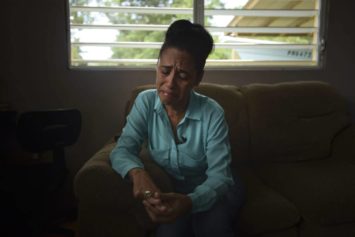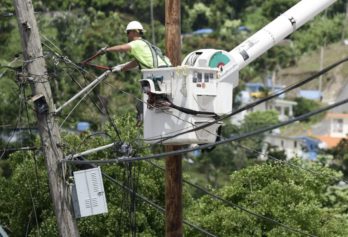The 2017 Atlantic hurricane season, which is still in progress, may be the most intense season to date. The season has already seen two record-breaking hurricanes and a level of destruction the Caribbean has not seen since 2005.
“This hurricane stayed in the country for a very, very long time and (was) just unrelenting,” Dominica Prime Minister Roosevelt Skerrit told CNN about Hurricane Maria, which packed wind speeds of 160 miles per hour when it touched ground on the island nation on Sept. 18. Skerrit described his nation, where at least 15 lives were lost, as being devastated by the storm. “I don’t think there were very many roofs which would survive the hurricane.”
“So far we have lost all what money can buy and replace,” the prime minister added in a Facebook post.
In Puerto Rico, where Maria made landfall as Category 4 hurricane on Sept. 20, the long-term loss of electricity to the entire territory’s populace and the potential collapse of the nation’s critical infrastructure, such as the fissuring of the Guajataca Dam, have left millions in direct danger or severely compromised. The U.S. Virgin Islands is currently coping with a collapse of its communication network, as major flooding and downed utility lines plague the islands. The American Caribbean territories are unlikely to recover from these disasters soon. Both territories faced financial crises before the storms. Post-storm aid has been promised by Washington but has been slow to arrive.
Frances Colon, founder of the non-profit group Cenadores, speaking to NBCNews, argues that the scale of the federal response in Puerto Rico has not been on the scale of the devastation. “We still have townships not reached. The government had a diesel ship parked in the bay and the government and National Guard is so maxed out they couldn’t ensure security so the fuel could reach its destination,” Colon said. “We need boots on the ground from the federal government. We need FEMA, National Guard, a federal response at [Hurricane] Katrina scale.”
For many in the American Caribbean — particularly, in light of collapsed communications — the coverage in the United States of the storms’ impact in Florida and Texas seemed to take precedence over island coverage.
“It’s getting very hairy over there,” Steve Thomas, a U.S. Virgin Islands restaurateur, said to the Miami Herald about his home territory, where St. John and St. Thomas took hits from Hurricane Irma on Sept. 6 and St. Croix was blasted by Hurricane Maria on Sept. 19. “And nobody is talking about us. It’s like they forget that we’re all Americans.”
Hurricane Irma is responsible for at least 102 deaths, with 58 of the deaths being on the mainland United States. The hurricane left what CNN described as a “nuclear landscape” on the Caribbean. Barbuda saw 95 percent of all of its structures destroyed. Water and telecommunications facilities have been destroyed, and much of the island’s native wildlife is feared to be lost.
Puerto Rico was declared a federal disaster zone a few days following Maria. FEMA established an air bridge — continuous air shipments involving four aircraft — to deliver essential supplies to the island on September 22.
The extent of the damage caused by Maria to Puerto Rico currently occupies the news cycle. However, the fickleness of the media’s attention may mean that the recovery effort will be compromised once the public’s attention wanes.
As territories of the United States, Puerto Rico and the U.S. Virgin Islands are both entitled to federal emergency aid. However, the fact that territories do not have a vote in Congress — they have non-voting delegates to the House of Representatives — means that territorial interest can often take a back seat to state interests, especially regarding resource allocations. Both of the American Caribbean territories were facing crippling debt.
Donald Trump has indicated that relief aid is on its way to Puerto Rico. “Texas & Florida are doing great but Puerto Rico, which was already suffering from broken infrastructure & massive debt, is in deep trouble,” Trump tweeted on Sept. 25 regarding Puerto Rico’s plight.
It is unlikely that the federal government will come up with the funding needed to restore the livelihood of Puerto Rican’s and U.S. Virgin Islanders to what it was pre-storm. In light of this and with both Texas and Florida facing shortfalls in their recovery funding, the impetus to help the territories’ residents may need to come from the public. With most of the Caribbean being either predominately Black or Latinx, or both, race relations tend to play an integral role on how these islands are seen and treated by the outside world.
Karla Mastracchio is a communication strategist and communication professor at the University of South Florida. Mastracchio pointed out that media follow the perceptions of its audience.
“While this does not apply to all journalism, as a rule, most people focus on what they didn’t expect,” Mastracchio said. “If people expect hurricanes to hit the Caribbean, stories about hurricanes in the Caribbean will be downplayed. Coupled with the notion of identity politics, or the lack of sense that ‘this could happen to me,’ stories regarding Caribbean devastation tend not to have a sense of urgency in the media. It is almost a sense of ‘this is what you get when you live in the Caribbean’ narrative of blame.”
This disconnect leads to the trivialization of non-white disaster victims. As the Caribbean tends to hold a temporal place in the American consciousness — a place that is visited and enjoyed for a short amount of time and then forgotten — the reality of what happens there once the tourists leave tend to be ignored. This, however, does not trivialize that millions will be forced to live the ramifications of this hurricane season for years to come.
“We have developed a language of inevitability when it comes to the Caribbean. They were already in danger for living in a known hurricane zone, this language of inevitability say. So, when it finally happens, there is no sense of empathy. While the extremeness of a Category 5 hitting may make up for what would otherwise be a tuning out of the story, it shouldn’t be lost that for many of the other islands not hit by Maria, the media has moved on.”
Regardless of the politics involved, it is the sincere hope of this publication and the author of this article that those affected find relief quickly. You can learn how to donate to the recovery fund by visiting the UNICEF USA, and the International Medical Corps pages. You can also give to local charities, such as ConPRmetidos and Unidos por Puerto Rico.


